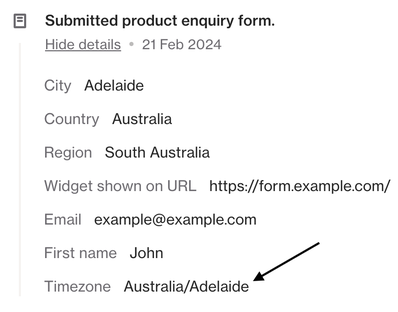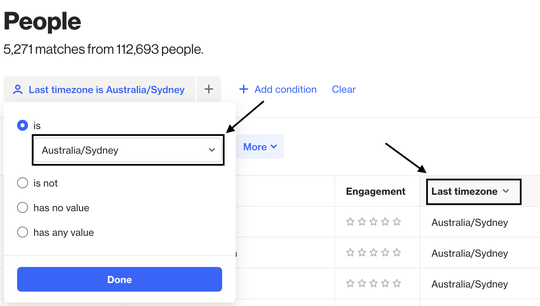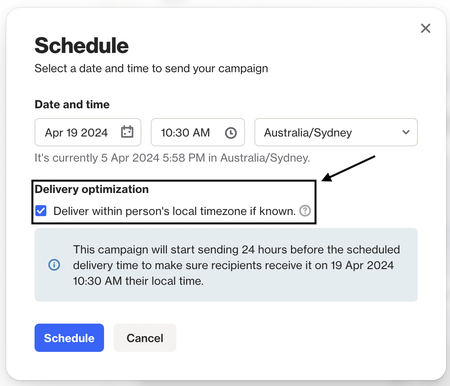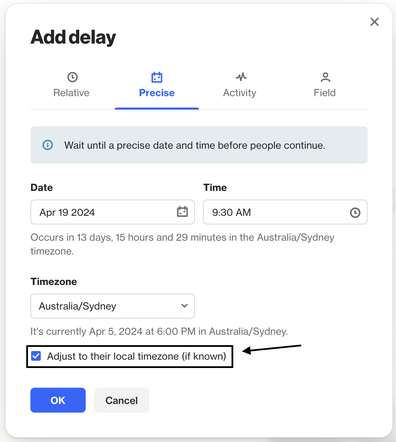Understanding and using a person’s timezone in Ortto
Overview
In your CDP, a person's profile includes a Last Timezone field that indicates their timezone. You may also see a Timezone activity attribute linked to specific actions they've taken, such as viewing a capture widget or opening an email.
Timezone data is collected based on activities triggered by your tracking code or the person’s IP address. This includes:
- Interactions with content (e.g., clicking an email, SMS, or push notification).
- Interactions with a capture widget (e.g., submitting a form).
- Visits to a web page with the Ortto tracking code installed.
If a person has not engaged in these activities, no timezone data will be available for them.
Viewing a person's timezone
Navigate to CDP > People > Select a Contact

NOTE: If a contact is using a VPN, their location may appear as a different country, even though they are actually in a different location. This happens because the VPN masks their true IP address and assigns one from another country.
What is the difference between Timezone and Last timezone?
- Timezone is an activity attribute that shows the timezone a person was in when they interacted with your content or website (e.g., engaging with a capture widget).
- Last timezone refers to the most recent timezone recorded for a person, based on their latest activity. It’s updated with each interaction that includes location data, providing the most current information about their timezone.
EX: Timezone activity attribute:

The Last timezone field can be used in the following ways:
- Segment people: Select it to create segments, save audiences, send campaigns, or export/archive data.
- Display in your CDP: Show it in your CDP to quickly view your contacts’ most recent timezones.

Can a person’s timezone be changed?
- The Timezone attribute reflects the timezone of a specific activity and is tied to that event. It won’t change unless the person performs the activity from a different location, in which case you may see different timezones for each event.
- The Last timezone value is updated each time a new activity with location data is recorded. It can change frequently, especially if the person interacts with your content from different locations (e.g., while traveling). You cannot manually change the Last Timezone in Ortto.
- If you're sending custom activity events via the Ortto API, you can manually set the timezone by including the location data in the event payload. This will update both the Timezone attribute and the person’s Last Timezone field.
Learn more about sending location data for an activity event via the API.
How to use a person’s timezone in Ortto
Access to your customers' timezone data helps you send more personalized campaigns that arrive at the right time with relevant content. Here’s how you can use timezone data in Ortto:
- Schedule campaigns: Send email or SMS campaigns based on a person’s local timezone, ensuring timely delivery (e.g., for event reminders).
- Journey delays & time conditions: Apply delays or time-based conditions to journeys, tailored to a person’s local timezone.
- Personalize content: Use timezone data to adjust or conditionally format content in your campaigns (e.g., time-sensitive offers or messages).
Schedule a campaign to send in a person’s timezone
You can schedule email and SMS campaigns to send at a specific date and time. By selecting Delivery optimization, the campaign will be sent at the right time in the recipient’s local timezone.
NOTE:
- Delivery optimization uses the person’s Last timezone value to determine their local timezone.
- You can find this option at the Review step when scheduling your email or SMS campaign.

Set journey shapes to occur in a person’s timezone
In a journey, you can set Delay and Time condition shapes to match a person’s local timezone.
EX: Just select the relevant checkbox in the shape setup, like in this delay configuration example:

NOTE: The Adjust to their local timezone (if known) option uses the person’s Last Timezone value to determine their local timezone.
Use merge tags for conditional formatting or to populate timezone values
You can use a person’s Last timezone value to create conditional formatting in an email.
EX: To show content to people in Melbourne, set a row condition based on their timezone, like this:

